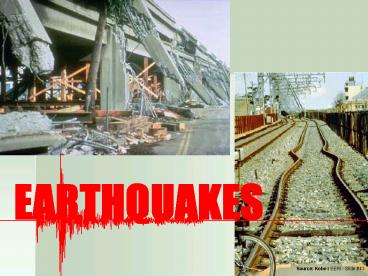EARTHQUAKES - PowerPoint PPT Presentation
1 / 53
Title: EARTHQUAKES
1
EARTHQUAKES
Source Kobe I EERI - Slide 43
2
Earthquakes are a natural phenomena, like
drought, flood and Cyclones.
Earthquakes in simple terms is a sudden trembling
or shaking movement of the earth surface.
Larger earthquakes usually preceded by tremors
and some violent shocks and followed by
smaller earthquakes of diminishing size called
aftershocks.
3
What are Earthquakes?
A sudden release of energy accumulated in
deformed rocks causing the ground to tremble or
shake.
- Causes rupturing or brittle failure of crustal
rocks.
- Energy is released. - Movement of fault blocks
takes place along a fault plane.
Source www.earth.leeds.ac.uk/dynamicearth
4
INSIDE EARTH
5
Layers of the Earth By analyzing the seismograms
from many earthquakes, scientists have discovered
that three main levels or shells exist within the
Earth
CRUST The Earth's outermost surface is called
the crust. The crust is relatively light and
brittle. Most earthquakes occur within the crust.
Scientists believe that below the lithosphere is
a relatively narrow, mobile zone in the mantle
called the asthenosphere (from asthenes, Greek
for weak).
Source www.thetech.org
MANTLE The region just below the crust and
extending all the way down to the Earth's core is
called the mantle. The mantle, a dense, hot layer
of semi-solid rock approximately 2,900 km thick.
CORE Beneath the mantle is the Earth's core.
The Earth's core consists of a fluid outer core
and a solid inner core.
6
Local convective currents in the mantle
7
Major Tectonic plates on the Earths surface
8
Types of inter plate boundaries
9
Types of Faults
10
Basic Terminology
11
Arrival of seismic wave at a site
12
SEISMIC WAVES
Seismic waves are of two types
- Body
waves - Surface waves
Body waves consist of Primary waves (P-waves) and
Secondary waves (S-waves) Surface waves
consist of Love waves and Rayleigh waves
13
Types of Waves
14
(No Transcript)
15
MAGNITUDE
Magnitude is a quantitative measure of the actual
size of the earthquake. Its obtained from the
seismogram and accounts for the dependence of
the wave form amplitude on epicentral
distance. Increase in magnitude by 1.0 implies
10 times higher waveform amplitude and about 31
times higher energy released. For instance,
energy released in a M7.7 earthquake is about
1000 times that released in a M5.7 earthquake.
16
(No Transcript)
17
INTENSITY
Intensity is a qualitative measure of the actual
shaking at a location during an earthquake and
it is assigned in Roman Capital Letters There
are many intensity scales. Two commonly used ones
are 1) Modified Mercalli Intensity
(MMI) Scale. 2) MSK Scale Both
scales are quite similar and range from I(less
perceptive) to XII (most severe) The intensity
scales are based on three features of shaking
- perception by people and animals
- performance of buildings
- changes to surroundings
18
Basic Difference Magnitude versus Intensity
Reducing illumination with distance from an
electric bulb
19
(No Transcript)
20
Schematic of early Seismograph
Some typical accelerograms
21
Indian Subcontinent among the worlds most
disaster prone areas 65 of land vulnerable to
Earthquakes 8 of land vulnerable to Cyclones
5 of land vulnerable to Floods gt 1 million
houses damaged annually human, social, other
losses
22
PAST EARTHQUAKES IN INDIA
23
(No Transcript)
24
(No Transcript)
25
Seismic Zone Map of India Year-1962
26
Seismic Zone Map of India -1966
27
Seismic Zone Map of India -1970
28
Seismic Zone Map of India -2002
About 65 percent of the land area of India is
liable to seismic hazard damage (about 26 under
MSK Intensity VII, 18 under VIII and 12 under
IX and higher).
29
Seismic Map of Bihar
30
Earthquakes in Bihar
- 04 June 1764 Bihar WB Brd 6.0
- 23 Aug 1833 Nepal Brd 7.7
- 23 May 1866 Nepal Brd 7.0
- 23 May 1866 Jharkhand Bihar Brd 5.5
- 30 Sept 1868 Hazaribagh 5.7
- 07 Oct 1920 Bihar UP Brd 5.5
- 15 Jan 1934 Indo Nepal Brd 8.0
- 11 Jan 1962 Indo Nepal Brd 6.0
- 21 Aug 1988 Bihar Nepal Brd 6.8
31
- Should social development increase vulnerability?
- Uncontrolled/unplanned development
- Major cities in hazardous zones
- Srinagar, Guwahati all NE capitals are in zone
V - Jammu, Delhi, Patna, Jalandhar in IV
- Mumbai, Chennai,Calcutta, Ahmedabad, Trivandrum,
- Coimbatore, Kochi,Kozhikode in III
- Majority of buildings wherein do not conform.
32
Earthquake Risk
- Hazard Probability of ground motion
- Site effects Soil properties, topography
- presence of
Reservoirs (RIS), - Mines (MIS)
- Vulnerability Building types, Age
- Risk Hazard x Site effects x
Vulnerability
33
Earthquake Dont Kill People but Buildings
Do
34
VULNERABILITY
- 1819 Gujarat Kutch 8.0 (2000 deaths)
- 2001 Gujarat Bhuj 6.9 (13805 deaths)
- Increased vulnerability in two centuries
35
(No Transcript)
36
(No Transcript)
37
(No Transcript)
38
(No Transcript)
39
(No Transcript)
40
(No Transcript)
41
(No Transcript)
42
43
(No Transcript)
44
(No Transcript)
45
(No Transcript)
46
(No Transcript)
47
How Architectural Features Affect Buildings
During Earthquakes
48
(No Transcript)
49
(No Transcript)
50
The normal learning from others experiences.
Normal Long Term Human Response to Earthquakes
(Key, 1988)
51
The Himalayas among
the most seismic regions on earth..
- 1833 Bihar 8.7
- 1897 Assam 8.7
- 1900 Coimbatore-Palghat
- 1905 Kangra HP
- 1934 Bihar Nepal 8.3
- 1950 Assam 8.6
- 1991 Uttarkashi 6.6
- 1988 Bihar-Nepal 6.8
- 1999 Chamoli 6.8
- 2001 Bhuj 6.7
- Can we learn from others experiences?
- And our own?
- Can we let it happen again?
52
The fight against damage, destruction and death
from earthquake Continues.
53
Lets make a safer world
Thank You

